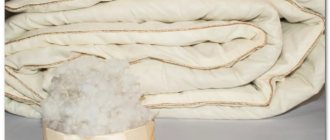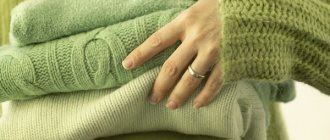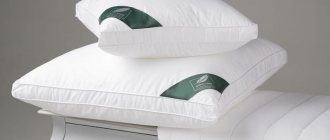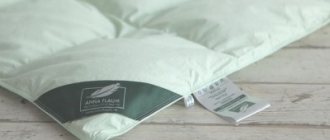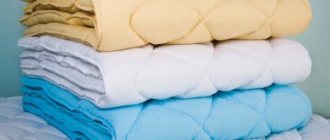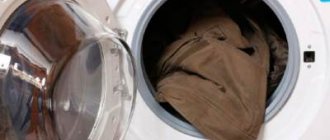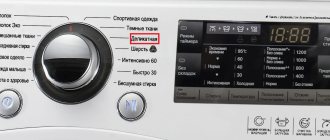For a long time, people have noticed the beneficial properties of sheep wool. They knitted mittens, socks, and clothes from it. A blanket made from such wool is very popular among consumers around the world. It is valued for its thermal qualities, healing effect, lightness and environmental friendliness.
A blanket made of sheep wool, if properly cared for, will last you for several decades, but, like all other things, it tends to get dirty. Such a product requires a special approach, so you cannot simply wash a blanket in a machine without the necessary knowledge.
In this article you can learn how to clean wool blankets without damaging the product itself.
What is special about sheep's wool?
Sheep wool is used in the production of all kinds of materials and things. It has both advantages and small disadvantages.
The advantages of sheep wool include:
- good breathability,
- durability,
- environmental friendliness,
- excellent thermal insulation properties,
- pleasant things to wear.
Unfortunately, this material also has disadvantages. These include:
- high cost of elite types of wool,
- difficulties in care,
- The product must be protected from moths.
Keratin is the main component of sheep wool. It is very durable, allows air to pass through well, but retains heat. The fleece itself is very elastic and resilient, capable of self-cleaning. The main value of sheep wool is its healing properties for health.
Reference! When we wear a sweater made of such material or cover ourselves with a blanket, several effects affect our body: electrostatic, irritating and warming. Those people who have arthritis, radiculitis, diseases of the joints, respiratory tract, and circulatory system will be able to appreciate the healing qualities of wool.
Wool also contains lanolin, which helps speed up wound healing and eliminates pain.
Woolen material for various products is obtained once a year, when the top layer of wool is sheared from sheep. This layer is called fleece. It is cleaned, combed and marked. To determine product quality, all indicators are taken into account.
The length of the wool is responsible for the class of raw material, and the type of yarn will depend on the thickness. An obvious sign of sheep's wool is its crimp. And the larger it is, the more expensive the wool, because it is these twisted hairs that prevent moisture from getting inside and protect against various debris.
Characteristics and varieties
When considering the properties of a material, you should not ignore the technology of its manufacture. Felt is called fabric very arbitrarily, because it is not woven
The production technology consists of dry or wet felting.
This process is made possible by the scaly structure of sheep wool. The fibers are tightly woven together, creating a dense and fairly hard material.
Based on the thickness and type of raw material, felt is divided into several varieties:
Technical
Types of felt
This type of material is used in the manufacture of substrates for linoleum, thermal insulation work and various types of filters. The cheapest types of natural wool or synthetic fibers are used as raw materials.
Felt
Hats, classic coats, bags and even shoes are made from it. The basis for felt can be either sheep wool, rabbit or goat wool. Raw materials are taken only of the highest quality, which makes the finished products soft and easy to take the desired shape.
Shoe
What is shoe felt?
Thick and dense material serves as the basis for stylish and warm felt boots and high boots. In addition to shoes, this type of felt is used in the manufacture of insoles.
Yurt
The self-explanatory name of the canvas accurately indicates its purpose. For centuries, the peoples of the far north and nomadic tribes have been using yurt felt to create yurts, folding huts suitable for habitation.
The material has an impressive list of advantages, the main ones include:
- strength and wear resistance;
- thermal insulation;
- good absorption of excess moisture;
- antibacterial effect;
- resistance to deformation.
Felt is resistant to deformation.
In addition, felt is considered a natural and environmentally friendly material. And the unique combination of frost resistance and lightness is proven by the popularity of felt boots.
Can it be processed by machine or by hand?
Only quilted or seamless items made from sheep's wool can be washed by hand.
Hand washing will not cause severe deformation to the products, so it is the best cleaning method. But it is very difficult and difficult to wash a blanket by hand, which after soaking in water has become 5 times heavier. Modern washing machines have a lot of different delicate modes, and this raises the question of whether it is possible to do without hand washing.
To answer it, you need to understand exactly what technology was used to make the blanket. Depending on this, the method of caring for the product will differ.
Have you tried washing a sheepskin blanket yet?
Not really
Quilted
If the blanket is quilted, then when making it, the wool base is placed in a stitched fabric cover and stitched again around the perimeter and center of the product so that the blanket does not curl up inside.
This blanket can be safely washed in a washing machine. It will not lose its original appearance.
But due to the fact that the blanket is very large and heavy, the washing machine may not withstand such a load and break. To keep the machine in working condition, you can wash it by hand.
Advice! When washing by hand, use warm water and detergents without strong fragrances. Before soaking your blanket, read the label on it. There will be all the basic data in the form of icons that indicate how to properly care for the product.
You need to dissolve the detergent in water, soak the blanket for a few minutes, rinse it and rinse it several times in clean water. If there are dirty spots, they should be carefully wiped with a sponge or soft brush. After rinsing, carefully squeeze out the water from the blanket.
Try not to twist it so as not to deform it. The product must be dried on a horizontal surface without direct sunlight and away from heating devices.
You shouldn't wash quilts too often because they will quickly lose their shape. And it doesn’t matter at all what artificial or natural fillers are inside, they deteriorate the same way.
For the long service life of such blankets, you need to change your bed linen in a timely manner. Periodically dry and air the product outside, and if stains appear, try to get rid of them immediately.
Whole woven
The product is made from a single piece of sheep's wool and can only be washed by hand. First, you should carefully read the instructions on the label.
Attention! If the blanket does not contain synthetic fibers, but only natural ones, then it is strictly forbidden to put it in the washing machine. Exposure to different temperatures and rotation of the bedding in a centrifuge will cause it to deteriorate greatly.
Washing a large wool product is a very labor-intensive and difficult process. You can clean a blanket by following simple rules.
- You will need a large container for a wool blanket. It must be completely submerged in water. The bathroom is perfect for this.
- Then, you need to take warm water and dissolve regular soap in it, if there is no special product for wool items. You can use shampoo. After it, the wool will be soft and fluffy.
- Dip the blanket into the prepared soap solution and leave for 10 minutes. Then we carefully wash it by hand so as not to spoil the wool or use a brush with soft bristles.
- After hand washing, drain the soapy water and add clean water. The temperature should not be too cold or too hot. Rinse the product.
- Now you should drain the water, carefully wring out the wool blanket and let it lie in the bath to drain off the remaining moisture. Then you should move on to drying the item.
The whole process is very labor-intensive and slow.
Fur
When fur products are made from wool, pile is woven into its base, which gives the blanket softness. These products look and feel very attractive, but do not tolerate any washing. You can bring them into proper shape only by dry cleaning at home or by turning to the services of dry cleaners.
Dry cleaning is a method of cleaning a product without using water or detergents. The main advantage for woolen items is the preservation of the appearance and fabric.
If the item does not have strong, complex stains, then any wool product can be cleaned in this way. After the procedure, it does not fade or deform, as there is minimal mechanical impact. Which subsequently extends the life of things.
Reference! Wool, velvet, silk, fur, natural suede, tweed - all these fabrics can be easily cleaned not by machine washing, but by dry cleaning.
But you need to follow certain rules to remove dirt and dust from such materials.
- The cleaning product should be tested on an inconspicuous area to avoid damaging the entire item.
- You should always wear gloves when working; cleaning substances may be safe for wool or fur, but not for your skin.
- Light-colored fabrics are cleaned with loose white substances, soda or starch. For dark ones, take sand or bran.
- All cleaning agents must be thoroughly removed from the product.
How do you wash a sheepskin blanket?
In a typewriterManually
How to wash a wool blanket at home
A sheepskin blanket is an excellent choice for those who value environmental friendliness, warmth and comfort. Wool fiber has good hygroscopicity, breathability, and excellent thermal insulation properties. To ensure that all these positive qualities are not lost after washing, you need to follow some rules.
Handwash
After making sure that there are no contraindications, you need to prepare a large container; it is best to wash such large items directly in the bath.
- Pour warm water into the bath; the temperature should not exceed 30 °C, as wool may mat and shrink under the influence of high temperatures and liquids.
- Dissolve a special liquid detergent for woolen items in water. If this is not the case, then you can use shampoo, but it is not recommended to use regular washing powder, since it does not dissolve completely, and its small particles can disrupt the structure of the wool fibers.
- Dip the blanket into the foam solution and lift it up. Do this several times.
- You can’t rub or wrinkle too much, since wool fibers have scales that cling to each other during friction, and the fiber becomes denser and will not warm as well.
- Rinse in cool water several times to ensure the detergent is completely removed.
Machine washable
This type of cleaning can only be used if there is a corresponding symbol on the product label.
- Pour liquid detergent for woolen items into the household chemicals compartment. Typically, such products contain lanolin, an animal wax that helps maintain the structure of the fibers.
- Machine wash on wool cycle. Some washing machine models have two temperatures for this mode - 30 °C and 40 °C. You should choose the smaller one.
- The spin function must be disabled.
Drying
- A washed blanket should not be wrung out or twisted.
- The water should be allowed to drain and dried in a horizontal position in a warm, well-ventilated room or outside.
- Do not hang on hot batteries.
Washing features
Closed type
The closed type includes quilted and cassette models.
In quilted ones, the wool fabric is placed inside the cover itself and everything is stitched on a sewing machine. Cassette is one canvas that combines individual volumetric elements. It is considered the most durable and durable. Blankets of this type themselves can be for different seasons, but they are all sewn using the same technology. Summer ones differ from winter ones only in the density of the fabric.
Closed-type bedding can be safely washed in a washing machine on a delicate cycle, because the wool inside is well stitched and will not bunch up.
Open type
All kinds of blankets and bedspreads are of the open type, since the woolen fabric is not inside, but outside. They can be double-sided, with the addition of polyester.
Such models require very careful care. Solid woven blankets can be cleaned by hand washing, while fur blankets can only be cleaned by dry cleaning.
Learn how to wash a duvet at home and learn how to properly wash a camel wool blanket.
A little about the features of blankets
Natural wool fibers are a product of processing animal hair, in most cases sheep of various breeds. Products made from such raw materials have a number of properties:
- high degree of aeration - fibers allow air to pass through without creating a “greenhouse effect”;
- excellent hygroscopicity - wool absorbs up to 30% moisture while remaining dry;
- safety – the products do not cause skin irritation or allergic reactions, which means they are successfully used even for small children.
The air that is between the curls of wool fibers is the best heat insulator, providing the high warming ability of blankets and blankets. Thanks to the elasticity of the raw materials, the products softly and pleasantly envelop the body, easily returning to their original state.
Doctors say that micromassage of the skin occurs with the help of wool fibers. It helps relieve tension and relax the body and is an excellent remedy for insomnia.
But, along with advantages, products made from natural wool also have negative properties. They cake over time, thickening and losing their appearance. Therefore, you need to care for such blankets and rugs only in strict accordance with the rules.
The best remedy
Wool has the ability to self-clean, but to maintain it in excellent condition, the fabric must be dry-cleaned or washed by hand with the addition of special products.
Washing powders are not suitable because they are difficult to wash out of a wool blanket. You need to use a special cleaner that contains lanolin. It is well suited for processing wool blankets.
Important! The most popular: Laska “Wool and Silk” washing gel, Luxus Professional Carpet Cleaner, LV Color washing liquid and BioMio washing gel.
These products are suitable for both dry and machine wash. They prevent matting and restore the structure of the coat.
Preparation
Before you wash your blankets in the washing machine or by hand, you need to prepare it for any of the selected procedures.
How to properly prepare (this also applies to pillows and down jackets filled with down):
- Remove the duvet cover and wash it separately at the appropriate temperature. Everything is indicated on the label. If there is no tag, find out what kind of fabric it is and place it in the drum with the appropriate mode set. After cleaning, the product should be placed in a clean duvet cover.
- Check the label for instructions. Icons: bath - means - can be washed in water, numbers in the tank or on the washing machine - maximum water temperature, hand in the basin - hand wash only, square with a circle inside - drying (the dots inside this symbol correspond to the drying temperature, 1 - low temperature , 2 - medium, 3 - high),
- Sew up all holes and ripped seams, this will prevent the filling from falling out during washing and drying.
- If cleaning has not been carried out for a long time, the blanket can be pre-soaked in a container that is large enough. Soaking lasts 1 hour.
If the washing machine has a small load, you can take the duvet to the dry cleaner. Then there is no need for preparation. All you have to do is remove the duvet cover and sew up the holes.
Machine washable
How to properly wash blankets that are machine washable?
The first thing you need to do is shake out all the dust and dry the blanket outside, out of direct sunlight. If the blanket is torn somewhere, then this hole should be sewn up. It is better to use special powders for washing the product. They should be free of bleach and harsh chemicals.
The next step is to place all the bedding in the drum of the washing machine. Select the delicate wash mode and set the temperature to no more than 30 degrees.
Attention! A very important point in washing at home. The spin cycle on the machine must be turned off or the washing machine will fail.
After completing the entire procedure, the blanket should lie in the machine for about an hour to allow the remaining water to drain. Then you should straighten it and dry it on a flat surface.
Ways to restore purity and freshness to a sheepskin blanket
If it's time for the big wash, you can choose one of the methods below:
- Dry cleaning. A method that does not require any costs from you other than financial ones. You simply take the item to a dry cleaning service and pick it up fresh, clean and fluffy. We don’t know how they will do this, but we don’t need to know. The main thing is that your strength was not wasted there.
- Handwash. This method has proven itself to be the most gentle. You can tactilely feel the limits of allowed effort when washing an item. However, sheep blankets, when they get into water, absorb it like a sponge, becoming simply mega heavy. For this reason, you physically cannot wash large models.
- Washing in an automatic washing machine. This is possible if your blanket fits into the drum of the machine rolled into a roll and there is still room for free rotation. It must be thoroughly shaken from dust before loading. Then place it inside, folded, and turn on the wool washing mode or, in other machines, the wool blanket washing mode. If there are no such modes, select the program manually - 30 degrees, low speed. For sheepskin, use gel products labeled wool/cashmere, as well as soft conditioners.
- Dry cleaning. This is the most correct way to clean a wool blanket from dirt. Manufacturers have taken care of a special product that contains lanolin, a substance that gives wool shine and silkiness. This product is diluted in the specified proportions with water, then it must be foamed tightly. For cleaning, they use foam, applying it to the surface. It dissolves all dust and dirt, after which you just need to remove it with wet movements.
Regarding drying the blanket, this can be done in the yard on a rope, near the radiator, or by stretching it out on a folding clothes dryer. Once dry it will look like new.
Having bought a sheepskin product or received it as a gift, at first it is so pleasant to enjoy its softness and warmth. But when it becomes dirty, the joy of the acquisition fades. With the help of the above methods, you can bring back that feeling and fall in love with your blanket again. Warmth and comfort to you!
Manual processing
When washing wool at home, ask someone to help you, as the weight of the wet item will increase greatly.
Washing a blanket is best done in the bathroom. Wool fibers absorb water well and greatly increase in size. You need to pour a lot of water; if there is not enough water, then all the bedding will be covered with stains and you will have to wash it again.
You should not use hot water, otherwise the canvas may shrink in size. It should be about 30 degrees. The blanket only needs to be soaked for 15 minutes. It is forbidden to rub wool too hard because it quickly pills and loses its shape. You need to wash it very carefully, making smooth movements.
Advice! Rinse several times until the soap components are completely rinsed out. You can’t squeeze it too hard, just squeeze out excess water and spread it on a horizontal surface. When the canvas dries, be sure to shake it vigorously and straighten out the lumps.
On what cycle should I wash a blanket?
As mentioned above, bamboo, as well as other fillers, can absorb detergents and create a lot of foam.
What mode to wash the blanket on:
- The ideal option is “wool” or “delicate wash” at a temperature of 30-40 degrees.
- Accordingly, during one rinsing cycle, the foam may not be washed out of the filler fibers. When the wash is finished, try touching the blanket.
- If it is very wet and a large amount of foam is released when pressed, set the machine to rinse and spin instead of washing. In this case, this will help remove any remaining detergent and further dry the blanket.
- This blanket is air dried . It's best not to hang it out. After all, the filler will slide down under its own weight. It should be smoothed on a horizontal surface.
- Pre-wash the table, lay a white sheet on it, and place a blanket on top . It's best to do this outdoors. It is better not to dry indoors, as stagnant air can cause the development of pathogenic microorganisms inside the filler.
- In this case, the product will begin to rot and smell unpleasant. You can dry it outside or on the balcony with the windows wide open.
Clean blanket
Dry cleaning
For fur products, dry clean only. Carpet cleaner with lanolin Luxus Professional Carpet cleaner will do an excellent job of stains on wool blankets.
Step-by-step dry cleaning:
- Vacuum the product thoroughly.
- Distribute the product evenly over it. If the wool blanket is large, then for convenience you need to process it by square meters.
- A damp sponge is good, but do not wipe the surface too hard until foam appears.
- Allow the product to dry for at least 3 hours and vacuum again.
- Place the blanket outside for ventilation.
This type of dry cleaning can quickly deal with a dirty blanket, and if you need to remove an unpleasant odor, then sprinkle the bedding with starch and leave it for a day. After this, carefully knock out or vacuum clean.
This article will tell you how to dry clean a carpet at home.
Whitening
Felted wool does not withstand chemical bleaching well. It is extremely undesirable to use aggressive compounds, and especially chlorine, on it. But this does not mean that it will definitely not be possible to return whiteness.
There are several effective remedies suitable for combating yellowness and gray tints:
- potato or corn starch;
- Wheat flour;
- crushed chalk;
- baking soda;
- semolina.
Starch is suitable for combating yellowness.
All of the listed products have absorbent functions. This allows them to be used on a dry surface. To achieve the result, they are simply applied to felt and left for several hours. After a while, the residues are brushed out or vacuumed.
How to remove difficult stains?
If the entire blanket is relatively clean, but there are heavy stains, they can be removed using proven products that are found in every home.
- Laundry soap. For better absorption of soap into the fabric, you need to grate it and dilute it with water to get a not very thick paste. For a more pleasant smell, you can add fabric conditioner or shampoo. This composition is applied to the stain and left for half an hour. Then wash it off.
- Liquid soap, soda and salt. These components are mixed in equal proportions and applied to the stain for 1 hour.
- Lemon juice. Removes stains well from white clothes. They should treat the stain and leave for 30 minutes. Instead of juice, you can use citric acid, first dissolve the crystals in warm water.
- Turpentine and ammonia. You can moisten a cotton pad with one of these liquids and treat the stain until it disappears completely.
Important! Any product that you used to remove stains from the canvas must be rinsed very well.
Read about removing stains from a carpet here and from a mattress here.
Cleaning blankets with exposed wool
Sheep wool is an environmentally friendly, natural fiber with unique advantages. Wool blankets are warm and comfortable. They will provide comfort, but require careful care. And the developers of modern programs for washing units have provided optimal washing conditions for them.
Method 1 - machine wash
A thin wool blanket can be machine washed.
The optimal water temperature, washing mode, drying conditions are indicated on the label. If there is no tag, then the symbol on the washing machine indicating the washing of woolen items guarantees ideal and safe cleaning.
According to the program table, wool requires minimal physical activity when washing.
8 rules of a quality process:
Consider the capacity of the drum
. Its characteristics will tell you whether a wool blanket can be washed in a machine. If the machine is designed for 5 kg, it can handle it easily.
Use a mesh bag
. Be sure to place the product in a washing net or duvet cover. Then the wool fluffs will not clog the filter.
Buy a 3 kg bag - this is the optimal size for a blanket.
Gel for wool products
. Only the gel solution actively removes dirt, and the powder will have to be washed off with an additional rinse.
Prefer gel to powder - it is easier to rinse out.
Special balls for washing
. You should also put a few tennis balls in the washing machine along with the blanket. Then they will fluff the product and prevent the formation of lumps.
Balls are catalysts for the process. Choose balls with blunt spikes to avoid damaging the wool weave.
Only low temperature conditions
. 30-40 degree water will not damage the material.
Set the minimum number of revolutions
. It should be programmed for delicate washing with a minimum of speed, or the “wool” indicator should be set.
Rinse thoroughly
. The rinsing procedure should be repeated twice so that the product is completely washed out.
Uniform drying
. It is better to dry the blanket by laying it out on the table, although you can hang it on several parallel clotheslines. After drying, you need to shake it, then the pile will become fluffy again. Lumps that form here and there during drying need to be fluffed up.
Method 2 - hand wash
You can wash individual places yourself.
Gently rub the stain with a brush from the edges to its center so as not to increase the extent of the contamination. Then carefully remove the foam with water.
For hand washing there are some universal tips:
- Pour 2/3 bath of water 30 degrees
. - Immerse the blanket
, folded crosswise 2-3 times (crumpled ones wash unevenly). - Let it get wet for 15 minutes
without your participation. - Dilute a detergent
special for woolen items with water and pour the solution evenly over the surface of the blanket.
Do not pour the powder into the water with the product; use only a ready-made soap solution.
- Lightly crumple and turn the product over
, but do not lift it so as not to deform it. - Open the bathtub drain
so that the water drains, while lightly pressing the blanket to the bottom of the bathtub, this is the only way to squeeze out the water.
Do not twist the woolen product, just squeeze it lightly!
Be sure to rinse, changing the water 2-3 times.
Filtered lemon juice will return the product to its original brightness, and the price of such a product is minimal.
- wringing a blanket
in a terry sheet without twisting is safe. - Next, it is recommended to dry
the product with ventilation and in a dry room.
Ventilation and lavender bags guarantee safe storage of wool and longevity for such items. Lavender repels moths.
How to dry it after?
Drying can only be done after all the water has drained out.
To begin with, the wool blanket must be laid out on a flat surface. Place a large terry sheet underneath and change to a dry one if necessary. As the blanket dries, be sure to turn it over.
When it is almost dry, you can hang it on the dryer. But you should not turn on the heaters or place bedding on the radiator. Wool does not like temperature changes.
If after drying the bedding has lost its shape, you need to shake it several times and beat it with your hands.
Manually
Washing a wool blanket and a down blanket by hand is very similar. In both cases, the help of another person will be required. The product becomes saturated with moisture and is difficult to unscrew or move to another place for drying.
How to wash a duvet:
- Pour enough water into the bath.
- Add detergent and whip it into foam.
- Place a blanket in the soapy solution and press down until it is completely immersed in the liquid.
- Leave it to soak for 60 minutes.
- You can't rub it. Wash with massage movements. Try to do everything as carefully as possible. If there are stains that you didn’t notice right away, go over them with laundry soap and a toothbrush.
- Rinse the blanket at least 3 times. All foam should come out.
- Squeeze with your hands and lay out to dry.
Blankets are washed by hand if the label shows a crossed out washing machine and there is an icon of a basin with hands in water.
Proper care
Any blanket, whether it is made of sheep or camel wool, must be well looked after. Change the duvet cover, ventilate and vacuum in a timely manner. If the product is very dirty, it is better to have it dry cleaned, because if it is not properly cared for or dried, an unpleasant odor may appear that will be difficult to get rid of.
Basic Rules:
- if a warm blanket is put away in the closet, then you need to put a moth repellent next to it;
- Be sure to ventilate the product in the fresh air;
- wash wool by hand in warm water and use special products with lanolin;
- always pay attention to the label or care instructions, all recommendations are indicated there;
- Some woolen fabrics cannot be washed (dry cleaning only), others are recommended to be washed exclusively by hand, and others can withstand washing in a washing machine;
- Ironing of wool blankets is excluded.
Helpful information
Tips that may be useful to all owners of a sheep's wool blanket:
- If you don’t have washing gel on hand, you can use hair shampoo, which needs to be thoroughly lathered. It can only be used for hand washing.
- It is difficult to wash a double wool blanket alone. You need to involve someone from your household in this activity.
- Difficult stains should not be attempted to be scrubbed off with a rough brush. To care for the product, use a soft foam sponge or your own hands.
- Before you start cleaning your blanket with a new detergent, you should test it on an inconspicuous area of the fabric.
